In this post, you’ll learn what is bevel protractor? its working, parts, types, applications, and more. You can also download a PDF file of this article at the end of it.
What is Bevel Protractor?
In geometry, a protractor is a circular or semicircular instrument used for measuring an angle or a circle. The units of measurement used are normally degrees. Some protractors are half-discs that have existed since ancient times.
More advanced protractors, like Bevel Protractors, have one or two swinging arms, which help in measuring the angle. A bevel protractor is a graduated circular protractor it has a pivoted arm used for measuring or marking off angles.
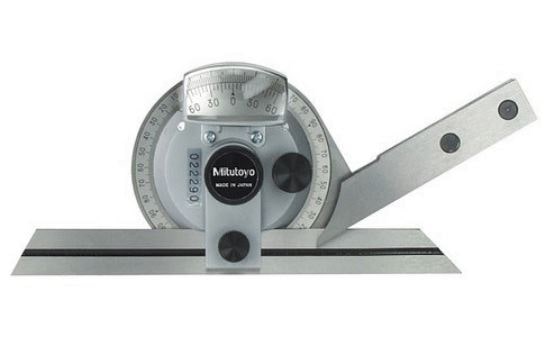
Sometimes vernier scales are attached to give more accurate readings. It has broad applications in mechanical and architecture however with the availability of modern drawing software like CAD the tool is less likely used in that sphere.
Universal bevel protractors are also utilized by toolmakers, as they measure angles by mechanical contact they are classified as mechanical protractors.
Read Also: Vernier Caliper: Parts, Types, Working Principle, Least Count, Errors
Parts of a Bevel Protractor
Following are the main parts of a bevel protractor:
- Base
- Magnifying glass
- Main scale
- Vernier scale
- Fine adjustment knob
- Locking nut
- Rule or blade
1. Base
When measuring the angle, the base is placed under the side of the angle.
2. Magnifying Glass
A bevel protractor comes with a magnifying glass, which helps when reading angles more precisely.
3. Main Scale
The main scale is also called a “primary scale” of this protractor, which has to measure angles in (as usual) degrees and is read first.
4. Vernier Scale
The vernier scale is also called a “secondary scale” and the angle can be measured with higher accuracy. It is measured in “minutes” and is read second.
5. Fine Adjustment Knob
It is designed to allow the user to move the blade around, especially with a higher degree of accuracy, when trying to create the final alignment to measure the object.
Read Also: What is Sine Bar? Working Principle, Construction, Formula, Application
Working of Bevel Protractor
In order to measure the angle between the two opposing faces of a component, a bevel protractor has to be used. The component whose angle needs to be measured has its faces aligned with the fixed measuring blade and the adjustable blade.
After that, a locking nut secures the blades, tightening the part for precise measurement. The body is formed from a circular scale that extends to form one of the blades. The circular scale is capable of measuring angles of up to 360 degrees.
Furthermore, the adjustable blade slides along its length to the rotating turret mounted on the body and can be locked at any point along its length. A bevel protractor can thus easily take accurate angular measurements of any component.
Main Scale & Vernier Scale Reading
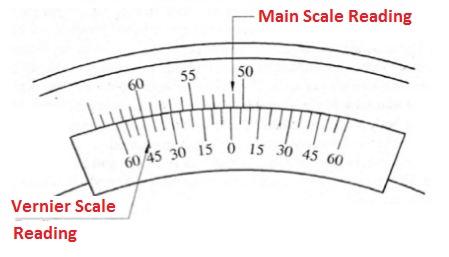
The figure shows on the main scale are graduated in degrees of arc. It has 12 divisions on each side of the center zero. These are marked 0-60 mins of the arc so that each division equals 1/12 of 60, that is 5 min of arc.
These 12 divisions occupy equal space as 23° on the main scale. Therefore each division of the vernier scale is equal to 1/12 of 23° or 1(11/12)°.
Thus the reading of the vernier protractor is equal to the largest “whole” degree of the main scale + the reading on the vernier scale in line with the main scale division.
= Main scale reading, 51° + Vernier 45 mark in line with the main scale
= 51°+ 45′
Types of Bevel Protractors
Following are the main two types:
- Mechanical bevel protractor
- Optical bevel protractor
The following figure shows the nomenclature of both types of bevel protractors.
#1 Mechanical Bevel Protractor
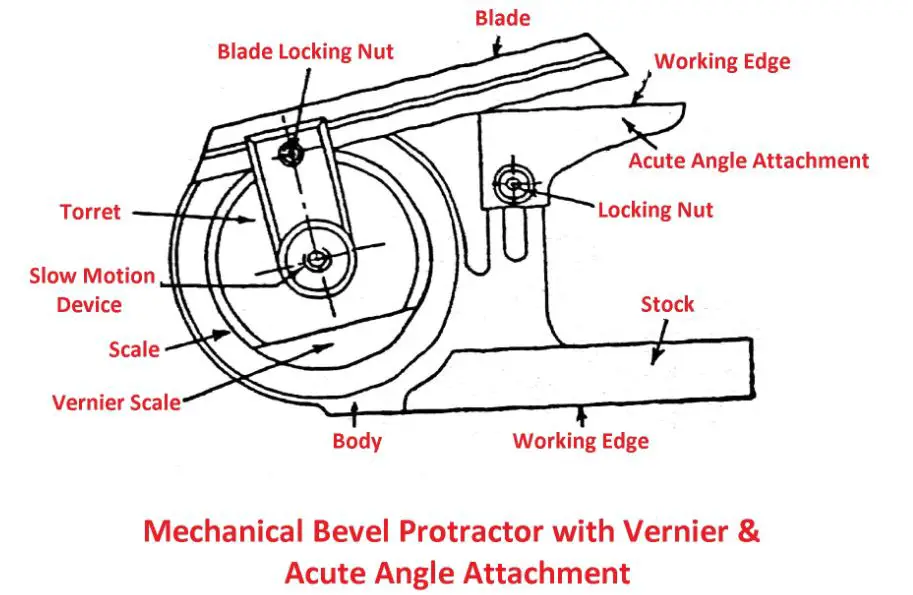
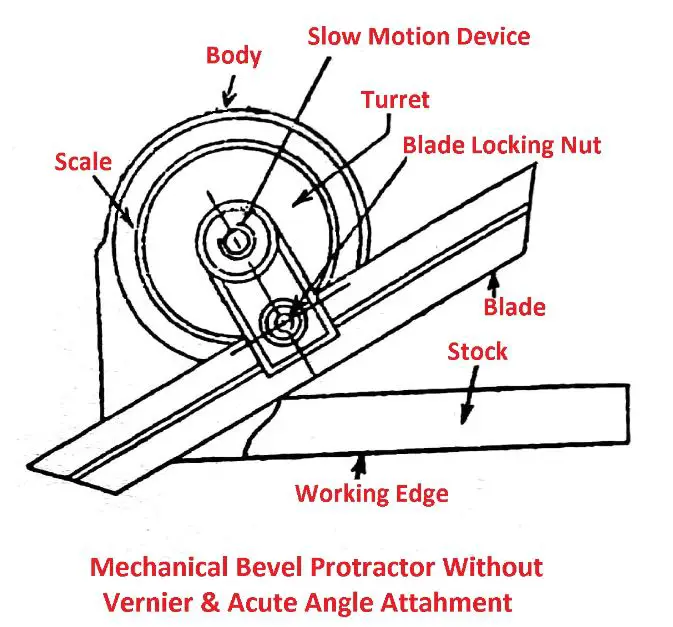
#2 Optical Bevel Protractor
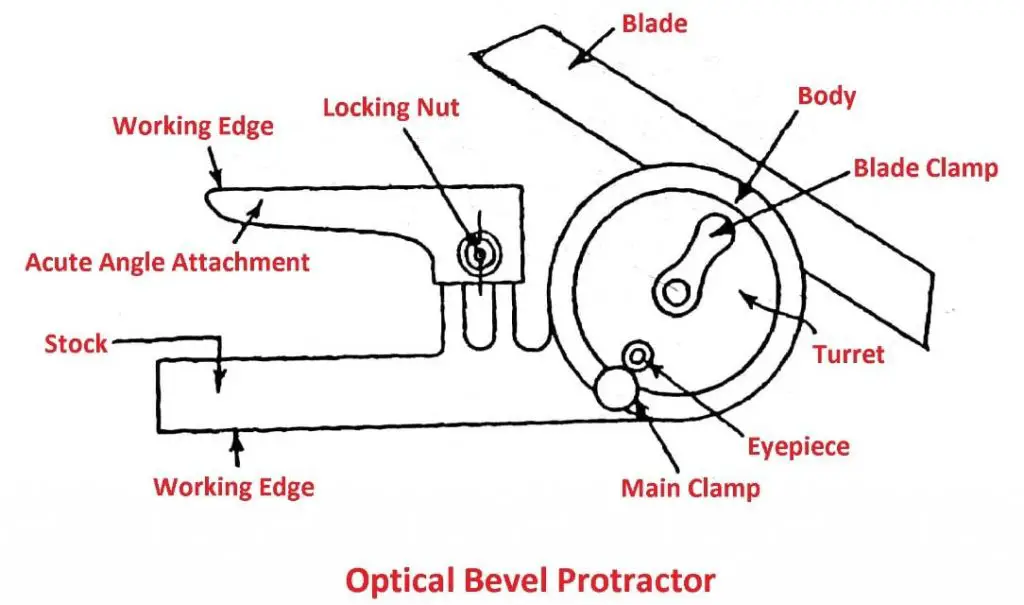
A circle divided at an interval of 1.0 mins in the entire circle is fitted on the inside of the body. A small microscope has been fitted through which circle graduation can be seen. The adjustable blade is attached to a rotating member that moves its microscope.
Read Also: 12 Different Types of Fasteners: Their Uses & Examples
Advantages
Following are the advantages of a bevel protractor:
- Bevel protractors are used to establish and test to-bear angles in very close tolerance.
- It can read 5 arcminutes (5′ or 112°) and can measure angles from 0 ° to 360 °.
- By using a bevel protractor you can get accurate measurements.
Applications
Following are the application of bevel protractors:
- It is used for checking the inside beveled face of a ground surface.
- Used for checking ‘V’ blocks.
- It is used to measure acute angles.
Conclusion
That’s it, thanks for reading. If you have any questions about this topic you ask me in the comments. If you like this article please share it with your friends.
Subscribe to our newsletter.
Download the PDF of this article:
Read Next:
Very easy to understand , print & also save the file.
Thanks
You’re most welcome.
so nice wawooo
Thank you 🙂